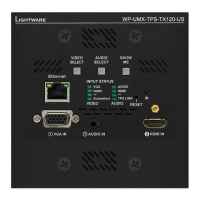UMX-TPS-TX100 series – User's Manual 93
The command is for sending a text message in ASCII-format via UDP-protocol. This method does not allow
escaping or inserting control characters.
Command and Response
Î <IP_address>:<port_no>=<text>)
Í
Example
Î
Í
The 'open' text is sent to the indicated IP:port address.
The command is for sending a binary message in Hexadecimal format via UDP protocol. This method does
not allow escaping or inserting control characters.
Command and Response
Î <IP_address>:<port_no>=<HEX_message>)
Í
Example
Î
Í
The '433030' message is sent to the indicated IP:port address.
INFO: There is no need to insert a space or other separator character between the binary messages.
The command is for sending a command message in ASCII-format. This method allows escaping the control
characters. For more information see the Escaping section.
Command and Response
Î <port>:sendMessage(<message>)
Í <port>:sendMessage
Example
Î
Í
The command is for sending a command message in ASCII-format. This method does not allow escaping the
control characters.
Command and Response
Î <port>:sendText(<message>)
Í <port>:sendText
Example
Î
Í
The 'open' text is sent out via the P1 serial port.
The command is for sending a command message in Hexadecimal-format. This method does not allow
escaping the control characters.
Command and Response
Î <port>:sendBinaryMessage(<message>)
Í <port>:sendBinaryMessage
Example
Î
Í
The '433030' message is sent out via the P1 serial port.
Hexadecimal codes can be inserted in the ASCII message when using:
sendMessage command: CALL /MEDIA/UART/P1:sendMessage(C00\x0D)
tcpMessage command: CALL /MEDIA/ETHERNET:tcpMessage(C00\x0D)
udpMessage command: CALL /MEDIA/ETHERNET:udpMessage(C00\x0D)
▪ C00: the message.
▪ \x: indicates that the following is a hexadecimal code.
▪ 0D: the hexadecimal code (Carriage Return).

